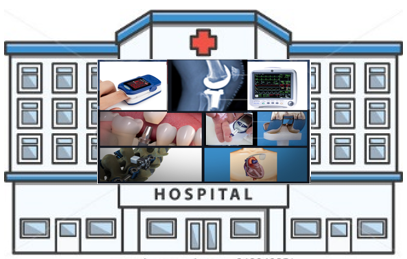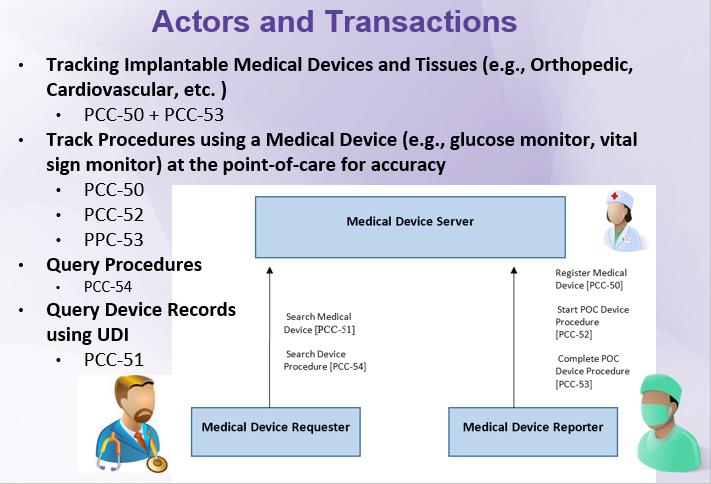Difference between revisions of "Point-of-Care Medical Device Tracking (PMDT)"
Tsoutherland (talk | contribs) m (Tsoutherland moved page Point-of-Care Medical Device Tracking to Point-of-Care Medical Device Tracking (PMDT): add) |
|||
| (46 intermediate revisions by 2 users not shown) | |||
| Line 1: | Line 1: | ||
| − | |||
| − | ==Summary== | + | |
| + | |||
| + | =='''Summary''' == | ||
| + | |||
The Point-of-Care Medical Device Tracking (PMDT) Profile closes the loop on data acquisition at the point-of-care in support of reporting data about implantable medical devices (e.g., pacemaker, titanium plates) and medical devices (e.g., vital sign monitors, pulse oximeters, blood glucose monitors) during a procedure (e.g., Continuous Pulse Oximetry - 4A19XCZ, Insertion Pacemaker - 0JH607Z, Open Reduction Internal Fixation Elbow - 0PSJ04Z). The approach to acquiring the medical device information at the point-of-care enables it to be retrieved and reused at a later time. | The Point-of-Care Medical Device Tracking (PMDT) Profile closes the loop on data acquisition at the point-of-care in support of reporting data about implantable medical devices (e.g., pacemaker, titanium plates) and medical devices (e.g., vital sign monitors, pulse oximeters, blood glucose monitors) during a procedure (e.g., Continuous Pulse Oximetry - 4A19XCZ, Insertion Pacemaker - 0JH607Z, Open Reduction Internal Fixation Elbow - 0PSJ04Z). The approach to acquiring the medical device information at the point-of-care enables it to be retrieved and reused at a later time. | ||
| − | |||
| − | + | [[Image:PMDT_General_IHE_wiki_Image.png|250px]] | |
| + | |||
| + | |||
| + | ''' | ||
| − | ==Benefits== | + | == '''Benefits''' == |
| − | The benefits of this profile are: | + | '''The benefits of this profile are: |
• '''Closes the loop on data acquisition at the point-of-care to support reporting of medical device data''' | • '''Closes the loop on data acquisition at the point-of-care to support reporting of medical device data''' | ||
| − | |||
| − | + | :o Medical device data can be exchanged with: | |
| − | + | ||
| − | + | :: * Other providers for continuum of care (e.g., Discharge Summary, Referrals) | |
| + | |||
| + | :: * Registries (e.g., Total Joint Registry) | ||
| − | + | :: * Payers for reimbursement (e.g., government provided, private insurance) | |
| − | + | :o Associating a medical device used for monitoring a disease or symptom of a disease (e.g., vital sign monitors, pulse oximeters, blood glucose monitors) to a patient for: | |
| − | + | ||
| + | :: * Querying the device or procedure using the medical devices UDI | ||
| + | |||
| + | :: * Accurately matching the device data with the correct patient | ||
• '''Increase patient safety''' | • '''Increase patient safety''' | ||
| − | o Traceability of medical devices (avoid use of counterfeit or illegitimate products) | + | :o Traceability of medical devices (avoid use of counterfeit or illegitimate products) |
| − | o Quality issues identified (e.g., recalls, adverse events) | + | |
| + | :o Quality issues identified (e.g., recalls, adverse events) | ||
• '''Increase accurate medical device data capture at the point-of-care''' | • '''Increase accurate medical device data capture at the point-of-care''' | ||
| − | o Eliminates human error from manual medical device data entry by using the devices unique device identifier (UDI) supplied in a structured format from the manufacturer | + | :o Eliminates human error from manual medical device data entry by using the devices unique device identifier (UDI) supplied in a structured format from the manufacturer |
| − | o Provides a standards-based mechanism to capture medical device information consistently across the care setting'' | + | |
| + | :o Provides a standards-based mechanism to capture medical device information consistently across the care setting'' | ||
| − | ==Details== | + | == '''Details''' == |
Implantable medical devices are essential for the treatment and management of a wide variety of medical conditions. These devices are costly and concerns about illegitimate (i.e., counterfeit, stolen) products being used for patient care has become a global issue. Post-market surveillance of implantable medical devices can be challenging due to the longevity of the patient and the medical device unless there is a reliable implant tracking method. Using the HL7 FHIR StructureDefinition Resources (HL7 FHIR Device, HL7 FHIR Procedure Resource) to record information about medical devices (the unique device identifier [UDI]), including implantable/life-supporting/life-sustaining devices and tissues, provides a reliable and standards-based mechanism to perform a search and query function by using the HL7 FHIR RESTful Services (HTTP/HTTPS) to create/update and query existing records. | Implantable medical devices are essential for the treatment and management of a wide variety of medical conditions. These devices are costly and concerns about illegitimate (i.e., counterfeit, stolen) products being used for patient care has become a global issue. Post-market surveillance of implantable medical devices can be challenging due to the longevity of the patient and the medical device unless there is a reliable implant tracking method. Using the HL7 FHIR StructureDefinition Resources (HL7 FHIR Device, HL7 FHIR Procedure Resource) to record information about medical devices (the unique device identifier [UDI]), including implantable/life-supporting/life-sustaining devices and tissues, provides a reliable and standards-based mechanism to perform a search and query function by using the HL7 FHIR RESTful Services (HTTP/HTTPS) to create/update and query existing records. | ||
| − | ==Systems Affected== | + | =='''Systems Affected'''== |
* Enterprise EHRs | * Enterprise EHRs | ||
| + | =='''Actors & Transactions:''' == | ||
| − | |||
| − | '' | + | [[Image:PMDTwikipageActorsTransactions_Image.png|400px]] |
| + | |||
| + | =='''Specification''' == | ||
| − | |||
'''Profile Status:''' [[Comments| Trial Implementation]] | '''Profile Status:''' [[Comments| Trial Implementation]] | ||
| + | |||
| + | * https://www.ihe.net/uploadedFiles/Documents/PCC/IHE_PCC_Suppl_PMDT.pdf | ||
'''Documents:''' | '''Documents:''' | ||
| − | + | [http://www.ihe.net/Technical_Framework/index.cfm# Patient Care Coordination (PCC) IHE PCC Technical Framework:] | |
| + | :* [http://ihe.net/uploadedFiles/Documents/PCC/IHE_PCC_TF_Vol1.pdf Vol. 1] - Integration Profiles | ||
| + | :* [http://ihe.net/uploadedFiles/Documents/PCC/IHE_PCC_TF_Vol2.pdf Vol. 2] - Transactions and Content Modules | ||
| + | |||
| − | |||
| − | |||
| − | |||
| − | |||
'''Underlying Standards:''' | '''Underlying Standards:''' | ||
| − | :* http://www.hl7.org/fhir | + | :* FHIR STU3 [http://www.hl7.org/fhir] |
| − | ==See Also== | + | =='''See Also'''== |
IHE PCD-01 transactions based on HL7 v2.7 ORU_R01 | IHE PCD-01 transactions based on HL7 v2.7 ORU_R01 | ||
| Line 70: | Line 82: | ||
'''Related Profiles''' | '''Related Profiles''' | ||
| − | |||
* IHE PCC Remote Patient Monitoring (RPM) Profile | * IHE PCC Remote Patient Monitoring (RPM) Profile | ||
| Line 76: | Line 87: | ||
| − | [[Category:Profiles]][[Category: | + | [[Category:Profiles]][[Category:Patient Care Coordination]] |
[[Category:FHIR]] | [[Category:FHIR]] | ||
Latest revision as of 18:20, 11 December 2020
Summary
The Point-of-Care Medical Device Tracking (PMDT) Profile closes the loop on data acquisition at the point-of-care in support of reporting data about implantable medical devices (e.g., pacemaker, titanium plates) and medical devices (e.g., vital sign monitors, pulse oximeters, blood glucose monitors) during a procedure (e.g., Continuous Pulse Oximetry - 4A19XCZ, Insertion Pacemaker - 0JH607Z, Open Reduction Internal Fixation Elbow - 0PSJ04Z). The approach to acquiring the medical device information at the point-of-care enables it to be retrieved and reused at a later time.
Benefits
The benefits of this profile are:
• Closes the loop on data acquisition at the point-of-care to support reporting of medical device data
- o Medical device data can be exchanged with:
- * Other providers for continuum of care (e.g., Discharge Summary, Referrals)
- * Registries (e.g., Total Joint Registry)
- * Payers for reimbursement (e.g., government provided, private insurance)
- o Associating a medical device used for monitoring a disease or symptom of a disease (e.g., vital sign monitors, pulse oximeters, blood glucose monitors) to a patient for:
- * Querying the device or procedure using the medical devices UDI
- * Accurately matching the device data with the correct patient
• Increase patient safety
- o Traceability of medical devices (avoid use of counterfeit or illegitimate products)
- o Quality issues identified (e.g., recalls, adverse events)
• Increase accurate medical device data capture at the point-of-care
- o Eliminates human error from manual medical device data entry by using the devices unique device identifier (UDI) supplied in a structured format from the manufacturer
- o Provides a standards-based mechanism to capture medical device information consistently across the care setting
Details
Implantable medical devices are essential for the treatment and management of a wide variety of medical conditions. These devices are costly and concerns about illegitimate (i.e., counterfeit, stolen) products being used for patient care has become a global issue. Post-market surveillance of implantable medical devices can be challenging due to the longevity of the patient and the medical device unless there is a reliable implant tracking method. Using the HL7 FHIR StructureDefinition Resources (HL7 FHIR Device, HL7 FHIR Procedure Resource) to record information about medical devices (the unique device identifier [UDI]), including implantable/life-supporting/life-sustaining devices and tissues, provides a reliable and standards-based mechanism to perform a search and query function by using the HL7 FHIR RESTful Services (HTTP/HTTPS) to create/update and query existing records.
Systems Affected
- Enterprise EHRs
Actors & Transactions:
Specification
Profile Status: Trial Implementation
Documents:
Patient Care Coordination (PCC) IHE PCC Technical Framework:
Underlying Standards:
- FHIR STU3 [1]
See Also
IHE PCD-01 transactions based on HL7 v2.7 ORU_R01
Related Profiles
- IHE PCC Remote Patient Monitoring (RPM) Profile

